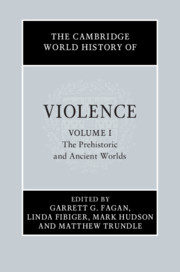Book contents
- The Cambridge World History of Violence
- The Cambridge History of Violence
- The Cambridge World History of Violence
- Copyright page
- Contents
- Figures
- Maps
- Contributors to Volume i
- General Introduction: Violence in World History
- Introduction to Volume I
- Part I The Origins of Conflict
- Part II Prehistoric and Ancient Warfare
- 8 Hunting and Warfare:The Ritualisation of Military Violence in Ancient Egypt
- 9 Recent Advances in the Archaeology of Maya Warfare
- 10 Violence and State Power in Early Mesopotamia
- 11 Violence and the Roman Way of Warfare
- 12 Roman Warfare and Military Violence in Late Antiquity
- 13 Violence and Warfare in Early Imperial China
- Part III Intimate and Collective Violence
- Part IV Religion, Ritual and Violence
- Part V Violence, Crime and the State
- Part VI Representations and Constructions of Violence
- Index
- References
9 - Recent Advances in the Archaeology of Maya Warfare
from Part II - Prehistoric and Ancient Warfare
Published online by Cambridge University Press: 13 March 2020
- The Cambridge World History of Violence
- The Cambridge History of Violence
- The Cambridge World History of Violence
- Copyright page
- Contents
- Figures
- Maps
- Contributors to Volume i
- General Introduction: Violence in World History
- Introduction to Volume I
- Part I The Origins of Conflict
- Part II Prehistoric and Ancient Warfare
- 8 Hunting and Warfare:The Ritualisation of Military Violence in Ancient Egypt
- 9 Recent Advances in the Archaeology of Maya Warfare
- 10 Violence and State Power in Early Mesopotamia
- 11 Violence and the Roman Way of Warfare
- 12 Roman Warfare and Military Violence in Late Antiquity
- 13 Violence and Warfare in Early Imperial China
- Part III Intimate and Collective Violence
- Part IV Religion, Ritual and Violence
- Part V Violence, Crime and the State
- Part VI Representations and Constructions of Violence
- Index
- References
Summary
It is now widely acknowledged that warfare played an important role in cultural developments throughout Maya history, including from its earliest origins. There is still much disagreement, however, over a number of fundamental aspects of Maya warfare, such as who participated in it, how it was conducted, the scale of conflicts and what the motivations were. This chapter provides a brief synthesis of current knowledge and controversies in the archaeology of ancient Maya warfare. First, a brief overview is provided of who the Maya are, the geographic region they have inhabited for over 3,000 years, the periods under study, and general patterns in how they conducted warfare. New findings produced by a diverse array of methods and specialists are then placed side by side and situated within their chronological and regional context. The focus here is on areas that have seen recent advances, in particular new archaeological evidence on the Preclassic period roots of Maya warfare, epigraphic advances showing the complexity of geopolitics during the Classic period in particular involving the Kaanul Snake kingdom, Postclassic mass burials and contact period war among Maya and between Maya and Spanish.
- Type
- Chapter
- Information
- The Cambridge World History of Violence , pp. 198 - 218Publisher: Cambridge University PressPrint publication year: 2020
References
Bibliographic Essay
- 1
- Cited by



